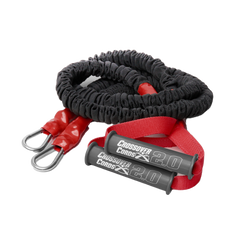A recent article went around pumping up the advantages of wrist cuffs when doing arm care. Although the advice was well intended, an even better option presents itself when you look deeper at the evidence.
You can read the article here: Why You Should Be Using The Wrist Cuffs On Your J-Bands, but the main point being made is by attaching the load to the wrists instead of gripping with the hands, you will increase the activation of the rotator cuff without compensations coming from secondary muscles.
While this theory sounds plausible, it is not supported by research. Alternatively, several studies show a positive correlation between hand-gripping activities and improved rotator cuff function (1-6).
We’ll explore this further so you can implement the best strategies to maximize your arm care routine.
What is the Law of Irradiation?
Muscle irradiation is a principle of human movement that states tension in one muscle will spread causing increased tension in adjacent muscles. As explained in the wrist cuff article, if you squeeze your fist tightly, tension is formed in the arm muscles all the way to the back.
Irradiation is presented as a bad thing in this other article regarding arm care. Suggesting that by gripping the wrist cuff, the larger muscles of the arms “overtake” the target muscles.
Stating that…
“If your goal is to improve muscular activation and recruitment around the shoulder girdle in isolation, we need to minimize the irradiation effect, NOT maximize it.”
But, dive deeper into research and biomechanics, and you’ll find that irradiation is not actually the enemy.
Instead, the opposite is true! A firm grip on a handle generates natural priming of the shoulder stabilizers to optimize the mechanics of the upper torso.
Get a Grip to Prime the Shoulders
Gripping creates anticipatory stability further up the chain at the shoulder and trunk. This occurs with a variety of limb positions and gripping intensities (1).
More specifically, submaximal gripping elicits significant increases in supraspinatus and infraspinatus (rotator cuff) activity, trapezius activity (scapula stabilizer), and a slight decrease in anterior and middle deltoid activity (2).
The translation is that gripping a handle increases rotator cuff and scap stabilizer activation and decreases the activation of the bigger shoulder muscles.
These relative levels of activation and inhibition are essential for initiating the proper muscle force couples needed for shoulder movement. A force couple describes the combined actions of muscles (co-contraction) that balance shoulder movement.
Contrary to the article’s point, the data actually shows that any changes generated by gripping a handle have a positive training effect with regard to shoulder stability, function, and shoulder health (3, 4, 5, 6).
Don’t Fear The Grip
There’s no doubt that baseball players shouldn’t train like bodybuilders. The goal for any pre-throwing band work should be priming the arm for throwing! Not getting beefy or setting powerlifting records!
Yet don’t fear the grip!
The belief that a handle grip will make you “stiff” for throwing is akin to the skinny girls thinking anything more than a pink dumbbell will make them bulky!
There’s not enough stimulus for that feared effect. Using your grip will only make movement stiff by trying to crush the handle in your palm or if the resistance is too heavy.
The goal of arm care should be smooth and dynamic coordination and co-contraction of muscles throughout the chain. This is best done through a variety of functional movement patterns that prime the body as a whole, not as isolated parts.
Also, remember your arm care program is for shoulder health and priming the shoulder complex so that it’s ready for the specific demands of a baseball player. It’s not supposed to be sport-specific training, but rather a developmental task for improving strength and movement.
If you’ve got a band with a wrist cuff, you should use the cuff. A weak grip with poor wrist control will more likely result in proximal compensations of the elbow, shoulder, or spine.
Although a much better option altogether is upgrading to a band with a solid handle to hold onto!
Research shows this is a better choice for coordinating muscle contractions that help to stabilize the arm during high-velocity throwing.
Article by: Matt Unthank, MS, CSCS
References
- Alizadehkhaiyat O1, Fisher AC, Kemp GJ, Vishwanathan K, Frostick SP. Shoulder muscle activation and fatigue during a controlled forceful hand grip task. J Electromyogr Kinesiol. 2011 Jun;21(3):478-82
- Sporrong H, Palmerud G, Herberts P. Hand grip increases shoulder muscle activity: an EMG analysis with static hand contractions in 9 subjects. Acta Orthop Scand 67: 485–490, 1996.
- Roberts LV, Stinear CM, Lewis GN, and Byblow WD. “Task-Dependent Modulation of Propriospinal Inputs to Human Shoulder.” Journal of Neurophysiology 100.4 (2008): 2109-114.
- Sporrong H, Palmerud G, Herberts P. Influences of handgrip on shoulder muscle activity. Eur J Appl Physiol Occupat Physiol 71: 485–492, 1995.
- Antony NT1, Keir PJ. Effects of posture, movement and hand load on shoulder muscle activity. J Electromyogr Kinesiol. 2010 Apr;20(2):191-8.
- Budoff JE1. The prevalence of rotator cuff weakness in patients with injured hands. J Hand Surg Am. 2004 Nov;29(6):1154-9.
 Shoulder Packages
Shoulder Packages
 Hip & Core Package
Hip & Core Package
 NEW - Crossover TORQ
NEW - Crossover TORQ
 Bundles
Bundles
 Accessories
Accessories
























